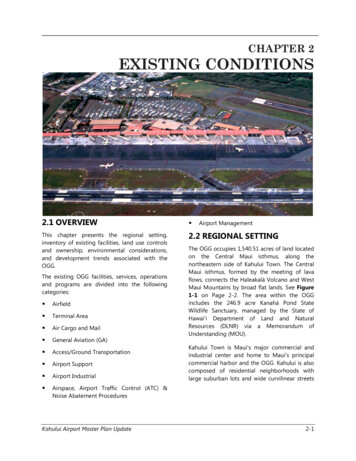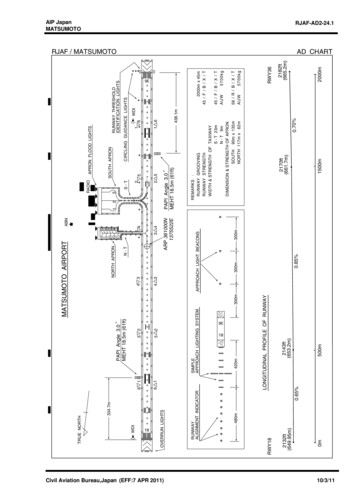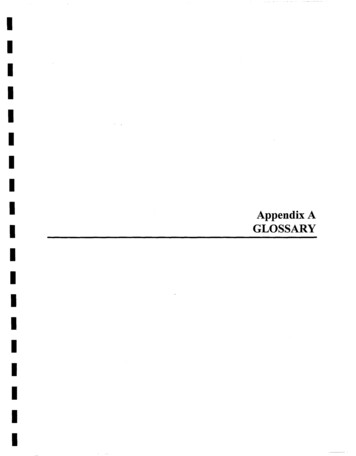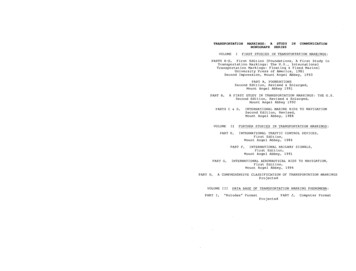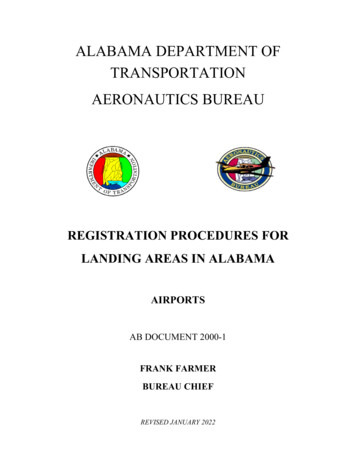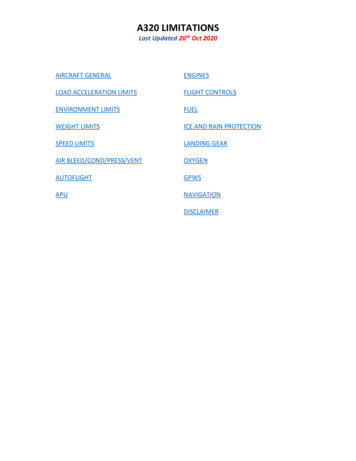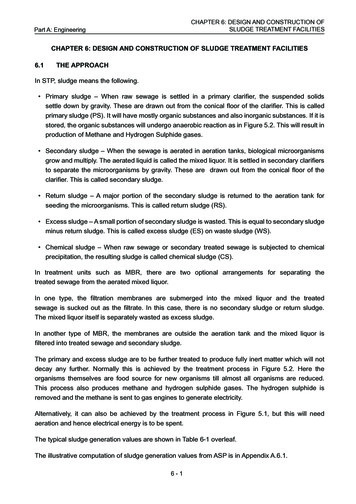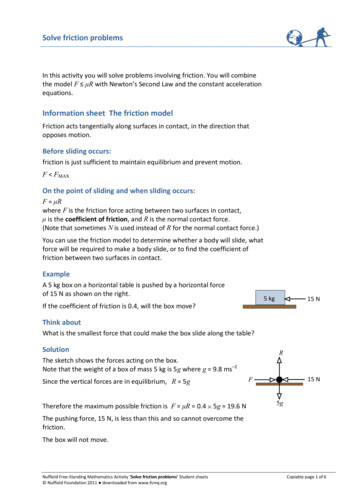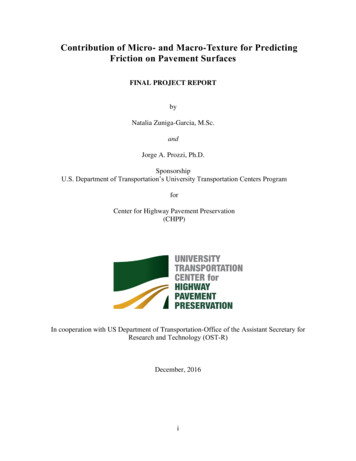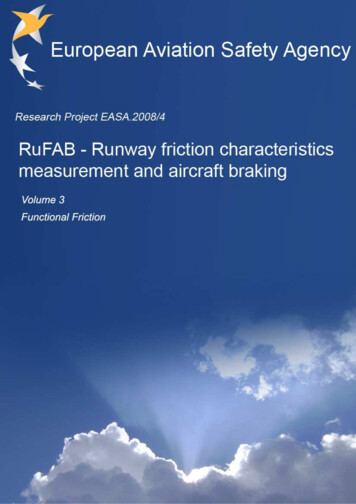
Transcription
DisclaimerThis study has been carried out for the European Aviation Safety Agency by anexternal organization and expresses the opinion of the organization undertakingthe study. It is provided for information purposes only and the views expressed inthe study have not been adopted, endorsed or in any way approved by theEuropean Aviation Safety Agency. Consequently it should not be relied upon as astatement, as any form of warranty, representation, undertaking, contractual, orother commitment binding in law upon the European Aviation Safety Agency.Ownership of all copyright and other intellectual property rights in this materialincluding any documentation, data and technical information, remains vested tothe European Aviation Safety Agency. All logo, copyrights, trademarks, andregistered trademarks that may be contained within are the property of theirrespective owners.Reproduction of this study, in whole or in part, is permitted under the conditionthat the full body of this Disclaimer remains clearly and visibly affixed at all timeswith such reproduced part.
6575Vol 3.FRRUNWAY FRICTION CHARACTERISTICS MEASUREMENTAND AIRCRAFT BRAKING (RuFAB)FINAL REPORTVOLUME 3 – FUNCTIONAL FRICTIONSubmitted in response toContract: EASA.2008.C46March 2010Submitted to:Mr. Werner Kleine-BeekResearch Project ManagerSafety Analysis and Research DepartmentExecutive DirectorateEuropean Aviation Safety Agency (EASA)Ottoplatz 1D-50679 CologneGermanySubmitted by:BMT FLEET TECHNOLOGY LIMITED311 Legget DriveKanata, ONK2K 1Z8BMT Contact: George ComfortTel: 613-592-2830, Ext. 226Fax: 613-592-4950Email: GComfort@fleetech.com
BMT Fleet Technology Limited6575Vol 3.FRBMT DOCUMENT QUALITY CONTROL DATA SHEETREPORT:Runway Friction Characteristics Measurement and Aircraft Braking(RuFAB): Volume 3 – Functional FrictionDATE:March 2010PREPARED BY:George Comfort, Group Leader, Cold Regions and MaterialsTechnology, BMT Fleet Technology Ltd.Dr. Zoltan Rado, Pennsylvania State University, State College,PA, USATerry Townshend, Townshend Technical Services, Bolton, ON,CanadaAl Mazur, BMT Fleet Technology LimitedREVIEWED BY:Razek Abdelnour, Ing, Senior ConsultantAPPROVED BY:George Comfort, BMT Fleet Technology Ltd.Runway Friction Characteristics Measurement and Aircraft Braking (RuFAB)i
BMT Fleet Technology Limited6575Vol 3.FRACRONYMS AND RROSANRuFABAmerican Association of State Highway and TransportationOfficialsAntilock Braking SystemAircraft Movement SurfaceAirport Surface Friction TesterAmerican Society for Testing and MaterialsBritish Pendulum NumberBritish Pendulum TesterCivil Aviation AuthorityCharge-Coupled DeviceComité Européen de Normalisation (France)Continuous Friction Measurement EquipmentCircular Texture MeterDecibel(s)Dynamic Friction TesterDirection Générale de l’Aviation Civile (France)European Aviation Safety AuthorityEuropean Friction IndexEngineering Sciences Data UnitEstimated Texture DepthFederal Aviation AdministrationFriction Measuring DeviceFlight Management SystemFriction NumberFriction Task ForceGlobal Positioning SystemHertzInternational Civil Aviation OrganizationInternational Friction IndexInternational Organization for StandardizationKilometre(s) per HourMetre(s)Millimetre(s)Mean Profile DepthMean Texture DepthNational Aeronautics and Space AdministrationNotice to AirmenOutflow MeterOutflow TimeResearch and DevelopmentRunway Condition ReportingRunway Friction TesterRoot Mean SquareRoad Analyzer and RecorderRoad Surface AnalyzerRunway Friction Characteristics Measurement and AircraftBrakingRunway Friction Characteristics Measurement and Aircraft Braking (RuFAB)Volume 3 – Functional Frictionii
BMT Fleet Technology LimitedSCRIMSFTSNSNOWTAMSPMSRMTALPAR ARCTDGTPUKUS(A)6575Vol 3.FRSideway Force Coefficient Routine Investigation MachineSaab Friction Tester or Surface Friction TesterSkid NumberSnow Warning To AirmenSand Patch MethodStuttgarter Reibungs-MesserTakeoff And Landing Performance Assessment AviationRulemaking CommitteeTexture Depth GaugeTechnical PublicationUnited KingdomUnites States (of America)Runway Friction Characteristics Measurement and Aircraft Braking (RuFAB)Volume 3 – Functional Frictioniii
6575Vol 3.FRBMT Fleet Technology LimitedTABLE OF CONTENTSACKNOWLEDGEMENTS . xEXECUTIVE SUMMARY . xi1INTRODUCTION . 11.1 Volume 3 . 11.1.1 Content of Volume 3 . 11.1.2 Notice Regarding Definition of Depth . 22FRICTION MEASURING EQUIPMENT . 32.1 Overview and Summary Comparisons . 32.1.1 High Speed Pavement Friction Test Methods . 32.1.2 Low Speed or Spot Friction Measurement Techniques . 72.2 Detailed Information for High Speed Friction Measuring Devices . 82.2.1 Locked Wheel Testers for Highways . 82.2.2 Fixed Slip Devices . 102.2.3 Side-Force Devices . 122.2.4 Variable Slip Devices. 142.3 Detailed Information for Low Speed Friction Measuring Devices . 172.3.1 Vehicle Braking Decelerometers . 172.3.2 British Pendulum Tester . 182.3.3 Dynamic Friction Tester . 193SCIENTIFIC AND OPERATIONAL CONSOLIDATIONS OF HARMONIZATION . 213.1 Present Practices for Friction Measurement . 213.2 Fixed Slip Devices . 213.2.1 Measurement Principle . 223.2.2 Design Characteristics and Procedures . 243.2.2.1 Important Design Characteristics . 243.2.2.2 Procedures. 273.3 Side Force Devices. 283.3.1 Measurement Principle . 283.3.2 Design Characteristics and Procedures . 293.3.2.1 Important Design Characteristics . 293.3.2.2 Procedures. 303.4 Calibration . 313.4.1 Static Calibration. 313.4.2 Dynamic Calibration . 313.4.2.1 Introduction. 313.4.2.2 Brief Summary of the Dynamic Calibration Process . 323.4.2.3 Difficulties with the Dynamic Calibration Process . 323.5 Summary . 333.6 Previous Harmonization Efforts. 343.6.1 Review of Previous Harmonization Efforts . 343.6.2 Model Development and Model Setup . 353.6.2.1 Fixed Slip Ratio and Side Slip Angle . 363.6.2.2 Derivation of Measured Friction Coefficient . 383.6.2.3 Tire Inflation Pressure . 383.6.2.4 Tire Parameters . 39Runway Friction Characteristics Measurement and Aircraft Braking (RuFAB)Volume 3 – Functional Frictioniv
BMT Fleet Technology Limited6575Vol 3.FR3.6.2.5 Self-Wetting Systems . 393.6.2.6 Conclusion . 403.6.3 Harmonization Trials . 413.6.4 Harmonization Models: Conversion to a Single Index . 433.6.4.1 General Approach Used by National Aviation Authorities . 433.6.4.2 The International Runway Friction Index (IRFI) . 433.6.4.3 The International Friction Index (IFI) . 443.6.4.4 The European Friction Index (EFI) . 453.6.5 Harmonization Models: Statistical Approach . 493.7 Correlation to Aircraft . 523.8 Status Review and Present Limitations . 583.8.1 Device Performance . 583.8.2 Incomplete Knowledge Base Regarding Some Key Parameters . 583.9 Synopsis of Current/Recent R&D Activities on Harmonization . 593.10 Summary . 643.11 Assessment of the Feasibility for Harmonization . 663.12 Overall Conclusions . 694ALTERNATIVE METHODS FOR SURFACE FRICTION EVALUATION . 714.1 Overall Review of Methods for Texture Measurements . 714.1.1 Introduction . 714.1.2 Texture Measurement Devices Capable of Highway Speeds: Laser TextureMeter . 774.1.3 Low Speed and Spot Texture Measurement Devices . 784.1.3.1 Circular Texture Meter . 784.1.3.2 Sand Patch Texture Meter . 794.1.3.3 Outflow Meter . 804.2 Conclusion on the Present Friction and Texture Measuring Technologies . 814.3 Alternative Methods to Evaluate Surface Friction Characteristics . 824.3.1 Option 1: The Kummer Model. 824.3.2 Option 2: Aircraft Based Assessment Method . 864.3.3 Option 3: Criteria Based on the Pavement Texture and GeometricalCharacteristics . 874.3.4 Option 4: Other Methods . 884.3.5 Potential for “Cross-Pollination” from Other Industries . 894.3.6 Summary and Conclusions. 905STEPWISE PROCEDURE AND GUIDELINES FOR HARMONIZATION . 925.1 CFMD Qualification Testing For Compliance with Various Standards . 925.1.1 Review and Evaluation of IFI, IRFI, EFI Quality Testing Standards andother Studies . 925.1.2 Recommendation . 945.1.2.1 Surface Selection Requirements . 955.1.2.2 Testing Process Requirements . 955.1.2.3 Determination of Quality Measures. 965.2 Review Technical Criteria for Measuring Device Compliance . 985.2.1 Material Reviewed . 985.2.2 Review of Content in Specifications . 985.2.2.1 Mechanical Design . 985.2.2.2 Output . 995.2.2.3 Operating Conditions . 99Runway Friction Characteristics Measurement and Aircraft Braking (RuFAB)Volume 3 – Functional Frictionv
BMT Fleet Technology Limited5.35.45.55.65.766575Vol 3.FR5.2.2.4 Repeatability . 995.2.2.5 Watering System. 995.2.2.6 Test Speed . 995.2.2.7 Device Documentation and Instrumentation . 995.2.2.8 Host Vehicle . 995.2.2.9 Test Tire . 1005.2.3 Overall Comments . 1005.2.4 Recommendation . 1005.2.4.1 Introduction. 1005.2.4.2 Basic Design and Measurement Requirements . 1005.2.4.3 Uncertainty and Stability of Measuring System . 1015.2.4.4 Measurement and Procedure-Related Requirements . 1025.2.4.5 Self-Wetting System . 1025.2.4.6 Data Recording and Electronic Signal Conditioning. 102Meeting Quality Requirements in Relation to Various Standards . 1035.3.1 Material Reviewed . 1035.3.2 Recommendation . 1035.3.2.1 Principles and Broad Guidelines . 1035.3.2.2 Description of Proposed Approach . 1075.3.2.3 Main Guidelines for Harmonization Testing ProcedureDevelopment . 1095.3.2.4 An Example for Harmonization Testing Process . 1125.3.2.5 Advantages of Proposed Approach . 115Propose the Establishment of a Reference Equipment Database Taking intoAccount Type of Equipment, Type and Location of Surface, etc. . 117Assess the Need to Issue Specific EASA Specifications in this Field . 1175.5.1 Review Present Specification . 117Proposals for Amendment of the ICAO Harmonization Table . 118Summary and Conclusions. 120REFERENCES . 122Runway Friction Characteristics Measurement and Aircraft Braking (RuFAB)Volume 3 – Functional Frictionvi
6575Vol 3.FRBMT Fleet Technology LimitedLIST OF ILLUSTRATIONSFigure 2.1: ASTM E274 Locked Wheel Testing Device . 8Figure 2.2: GripTester Fixed-Slip Friction Testing Device . 11Figure 2.3: SCRIM - Sideways Force Coefficient Routine Investigation Machine . 13Figure 2.4: The Mu Meter Side Force Friction Testing Device. 13Figure 2.5: The RUNAR Variable Slip Friction Testing Device . 15Figure 2.6: Mechanical (Bowmonk) and Electronic (ERD) Decelerometers . 17Figure 2.7: British Pendulum Tester . 19Figure 2.8: The Dynamic Friction Tester. 20Figure 3.1: Schematic for Mechanically-Braked Fixed Slip Measurement Principle . 23Figure 3.2: Schematic for Hydraulically-Braked Fixed Slip Measuring Principle . 23Figure 3.3: Standardized Friction Tires for SAAB, RFT, RUNAR, and other Devices . 24Figure 3.4: Standardized Friction Tires for the Grip Tester . 25Figure 3.5: Standardized Friction Tires for the IMAG and IRV Devices. 25Figure 3.6: Schematic Diagram for Side Force Coefficient Measurement Principle . 28Figure 3.7: Standardized Friction Tires for the Mu-Meter Device . 29Figure 3.8: General Schematic: Pavement Friction versus Tire Slip . 36Figure 3.9: EFI, IFI, and the PIARC Friction Models . 37Figure 3.10: Effect of Water Depth on Measured Friction Coefficient of Friction . 40Figure 3.11: Schematic of the ESDU Method (CROW, 2003) . 50Figure 3.12: Aircraft Braking (Mu) vs. Reference IRV . 54Figure 3.13: Aircraft Braking (Mu) vs. ERD . 55Figure 3.14: Aircraft Braking (Mu) vs. IRFI(ERD) with Non-Uniform Sites Removed . 55Figure 3.15: Aircraft Braking (Mu) vs. RUNAR . 56Figure 3.16: Aircraft Braking (Mu) vs. IRFI(RUNAR). 56Figure 3.17: Aircraft Braking (Mu) vs. SFT79 . 57Figure 3.18: Aircraft Braking (Mu) vs. IRFI(SFT79) . 57Figure 3.19: Predicted Harmonized Friction values Using the EDSU model for 40km/h. 59Figure 3.20: Predicted Harmonized Friction values Using the EDSU model for 65km/h. 60Figure 3.21: Predicted Harmonized Friction Values Using EDSU Model for 95 km/h . 60Figure 3.22: Predicted Harmonized Friction Values . 61Figure 3.23: Mu-Datum Parameter Consistency for the ESDU Model (CROW, 2006) . 63Figure 3.24: Variation of Kappa Runway Interaction Parameter in ESDU Model (CROW,2006) . 63Figure 3.25: Variation over Time for the “a” Constants in the IFI Model . 64Figure 3.26 Variation over Time for the “b” Constants in the IFI Model . 64Figure 3.27: Wallop NASA Site Surface Friction Changes over 8 Years as Measured by theVADOT E0274 Trailer . 67Figure 3.28: Wallop NASA Site Surface Friction Changes over 5 Years as Measured by theIMAG/IRV . 68Figure 3.29 Wallop NASA Site Surface Texture Changes over 8 Years as Measured by theCT Meter . 68Figure 3.30 Wallop NASA Site Surface Texture Changes over 8 Years as Measured by theSand Patch Method . 69Figure 4.1: The ROad Surface ANalyzer Laser Device (ROSAN). . 77Figure 4.2: The Circular Texture Meter . 78Figure 4.3 The Sand Patch Measurement Tools . 79Figure 4.4: The Outflow Meter . 81Runway Friction Characteristics Measurement and Aircraft Braking (RuFAB)Volume 3 – Functional Frictionvii
BMT Fleet Technology Limited6575Vol 3.FRFigure 4.5: Kummer's Unified Theory of Rubber and Tire Friction . 82Figure 4.6: Comparison Between Measured and Predicted Friction (Ergun, 2005) . 84Figure 4.7 Pavement Surface Profile by Stereo Photography. 85Figure 4.8 Equipment Setup for Stereo Photography . 85Figure 4.9 Schematic of Data Distribution for Aircraft Based Assessment Approach . 86Figure 4.10 Schematic for Aircraft Based Assessment Approach . 87Figure 4.11: Different Types of Friction Categories. 90Figure 5.1: Summary of Harmonization Process Development . 111Figure 5.2: Schematic of the Harmonization Process . 112Figure 5.3: Example Result of an ANOVA Analysis from MS Excel . 114Runway Friction Characteristics Measurement and Aircraft Braking (RuFAB)Volume 3 – Functional Frictionviii
6575Vol 3.FRBMT Fleet Technology LimitedLIST OF TABLESTable 2.1:Table 2.2:Table 2.3:Table 3.1:Table 3.2:Table 3.3:Table 3-4:Table 3.5:Table 4.1:Table 4.2:Table 4.3:Table 4.4:Table 4.5:Table 5.1:Table 5.2:Table 5.3:Table 5.4:Table 5.5:Table 5.6:Table 5.7:Overview of High Speed Pavement Friction Test Methods . 3Comparison of High Speed Pavement Friction Test Methods . 5Overview of Low Speed or Spot Friction Measurement Methods . 7Different Friction Measuring Devices Used at Airports . 21Relevant References Regarding Significance of Device Design Parameters . 35Relevant References Regarding Harmonization Trials . 41Relevant Harmonization Models Examined in the HERMES Project . 46Correlation Coefficients of Harmonized Friction Numbers of Different Devices toAircraft Braking Friction . 53Summary of Texture Measurement Methods: Laser Profiler Method . 73Low Speed or Spot Texture Test Methods: SPM, Grease Patch and OFM . 74Low Speed or Spot Texture Test Methods: CTM and TDG . 75Summary of Low Speed or Spot Pavement Surface Texture Test Methods . 76Norwegian Criteria (Unofficial) . 88Relevant References Related to Harmonization . 92Summary of Quality Testing Requirements for FMD . 93Relevant References: Technical Criteria for Friction Measuring Devices . 98Summary of Harmonization Testing Quality Requirements . 103Runway Friction Levels Specified by ICAO, 2004 (Table A-1) . 119Runway Friction Levels Advised by the FAA AC 150/5320-12C – 1997 . 119Example ICAO Equivalency Table . 120Runway Friction Characteristics Measurement and Aircraft Braking (RuFAB)Volume 3 – Functional Frictionix
6575Vol 3.FRBMT Fleet Technology LimitedACKNOWLEDGEMENTSWerner Kleine-Beek of EASA was the Project Officer.throughout to administer and facilitate the work.He is thanked for his effortsThe contributions of the Project Steering Committee (listed below) are acknowledged as well.Their contributions included attending project meetings, providing guidance regarding theapproach(es) for the project, providing information and references, reviewing thequestionnaires that were sent out, and facilitating contacts.Jean Baril, EASA;Rachel Daeschler, EASA;Xavier Vergez, EASA;Chris Gash, CAA-UK;John Matthews, EASA;Herbert Meyer, EASA;Ivan-David Nicolas, EASA;Armann Norheim, Avinor (Norway);Jerry Ostronic, FAA (USA);Vincenzo Pennetta, EASA;Francis Richards, Eurocontrol;Maria Algar Ruiz, EASA;Filippo Tomasello, EASA; andFrançois Watrin, DGAC-France.Acknowledgements are made to various members of the Project Steering Committee forproviding advance information regarding various ongoing initiatives as follows:Jerry Ostronic, for information regarding the TALPA ARC recommendations;François Watrin, for information regarding the French DGAC study; andArmann Norheim, for information regarding the ICAO FTF.Acknowledgements are also made to the various individuals and organizations whoresponded to the questionnaires which were sent out as part of the project. Although theycannot be named (to maintain their anonymity), their support is collectively acknowledged.Runway Friction Characteristics Measurement and Aircraft Braking (RuFAB)Volume 3 – Functional Frictionx
6575Vol 3.FRBMT Fleet Technology LimitedEXECUTIVE SUMMARYThis report constitutes the final submission under EASA Contract No. EASA.2008.C46 forthe Runway Friction Characteristics Measurement and Aircraft Braking (RuFAB) study,which was sponsored by the European Aviation Safety Authority (EASA) to investigate andharmonize:(a)Terminologies for runway surface conditions, related to functional and operationalfriction characteristics;(b)Functional characteristics as they relate to friction measurement reporting; and(c)Operational characteristics as they relate to runway surface condition assessmentand reporting, friction measurement, and aircraft braking.The overall objective of the work was to provide recommendations regarding the assessmentof runway friction characteristics and Runway Condition Reporting (RCR). This is a broadsubject, and thus, the project had several specific objectives, as generally summarized below:(a)To conduct a broad information-gathering effort to determine the current state-ofpractice.(b)To compare the various approaches and definitions used for RCR, and to suggestapproaches for harmonizing them.(c)To compare the various approaches used for assessing functional frictioncharacteristics, and to suggest approaches for harmonizing them. This included anevaluation of past approaches for harmonizing the readings from ground frictionmeasuring devices, and recommendations for an updated device equivalency table(to Table A-1 in ICAO Annex 14, Volume 1).(d)To compare the various approaches used for assessing operational frictioncharacteristics, and to suggest approaches for harmonizing them.This is Volume 3 of a four-volume series of reports describing the project, as follows: (a)Volume 1 – Summary of Findings and Recommendations; (b) Volume 2 - Documentationand Taxonomy; (c) Volume 3 - Functional Friction; and (d) Volume 4 - Operational Friction.It should be noted that all recommendations are only presented in Volume 1.Section 3 is divided with respect to the three main tasks in the scope of work related tofunctional friction assessments:(a)Scientific and Operational Consolidations of Harmonization;(b)Investigations forCharacteristics; and(c)Definition of a Stepwise Procedure and Guidelines for Harmonization.AlternativeMethodstoEvaluateRunway Friction Characteristics Measurement and Aircraft Braking (RuFAB)Volume 3 – Functional FrictionSurfaceFrictionxi
6575Vol 3.FRBMT Fleet Technology LimitedThe last sub-section of Section 3 presents recommendations regarding updates to the deviceequivalency table in ICAO Annex 14, Volume 1.Scientific and Operat
Runway Friction Characteristics Measurement and Aircraft Braking (RuFAB) iii Volume 3 - Functional Friction SCRIM Sideway Force Coefficient Routine Investigation Machine SFT Saab Friction Tester or Surface Friction Tester SN Skid Number SNOWTAM Snow Warning To Airmen SPM Sand Patch Method SRM Stuttgarter Reibungs-Messer
